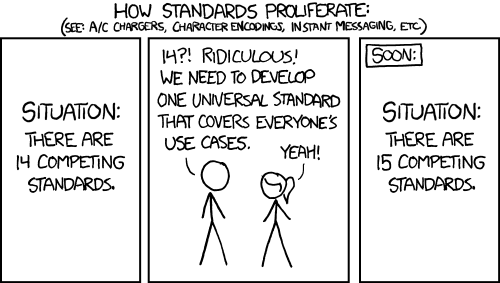If every EHR implements their own unique standard, or, even their own unique flavor of a common standard (such as FHIR), it makes intuitive sense to invent a universal standard to consolidate them all, right? Well, there's an old joke about that.

Should I Create a New Data Model?
You may be tempted to create a new data model or to consider services that create one for you. A universal data model simplifies things. It allows you to use the same code for every platform or situation. It certainly has its benefits, but before investing in it, you should also consider the costs.
When using a service that creates a universal data model, you are locking your app into that company's data model. You're trusting that they will continue to support it, that it will be stable, and that it will have longevity. It will be difficult to eject your app should you decide to take another direction, because your entire application will be dependent on this data model.
Additionally, services that consolidate different data models into one are adding an additional layer between your app and the data. This additional layer adds potential risks and may have some performance impact.
What Should I Do?
If your application has an existing data model, you should map to that. It's going to be extra work for the developers, but with good coding practices, it doesn't have to be painful. Map everything to your data structure and then you own the data. You are free to modify it as you wish. You are not trapped beneath another service's decisions.
FHIR Standard
At Plasma Health, we stick to the FHIR standards and supply a utility framework to make working with it easier. Is FHIR a perfect data model? No. Does FHIR exist? Yes.
We strive to make interacting with EHRs as easy as possible and we want your app to be able to develop and innovate quickly. Our framework facilitates that, but at the end of the day, it's still using FHIR. Support for FHIR across EHRs is growing rapidly and Plasma Health can help bridge the gap between an EHR's FHIR service and your application. And if you ever decide to eject from the Plasma Framework, your app was still written to the FHIR specification rather than a proprietary data model.
